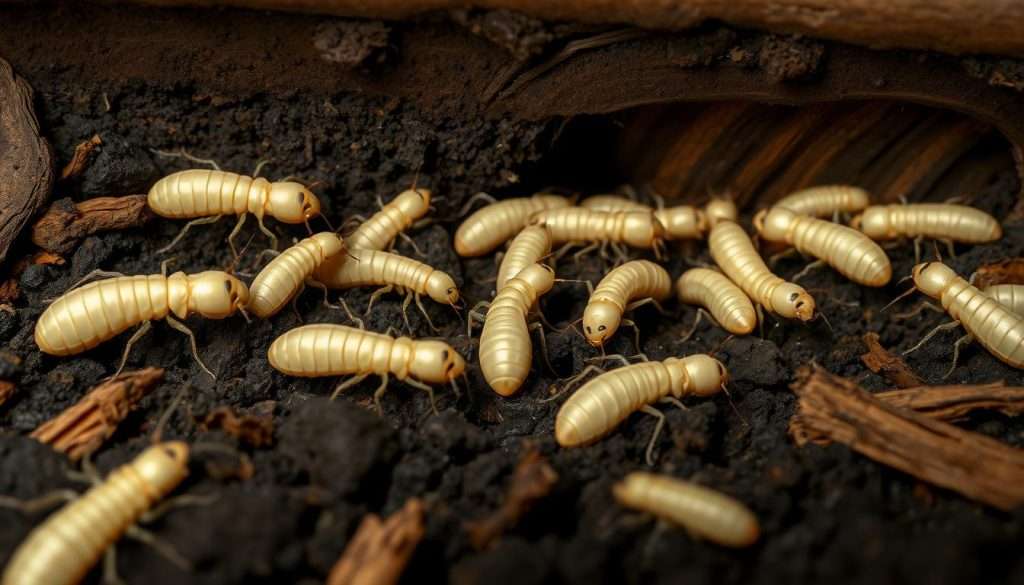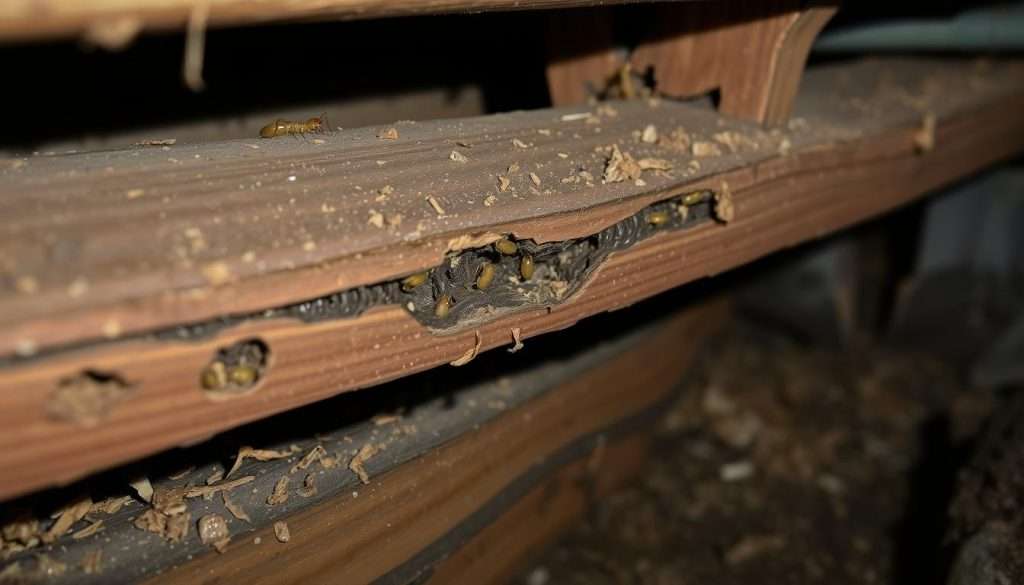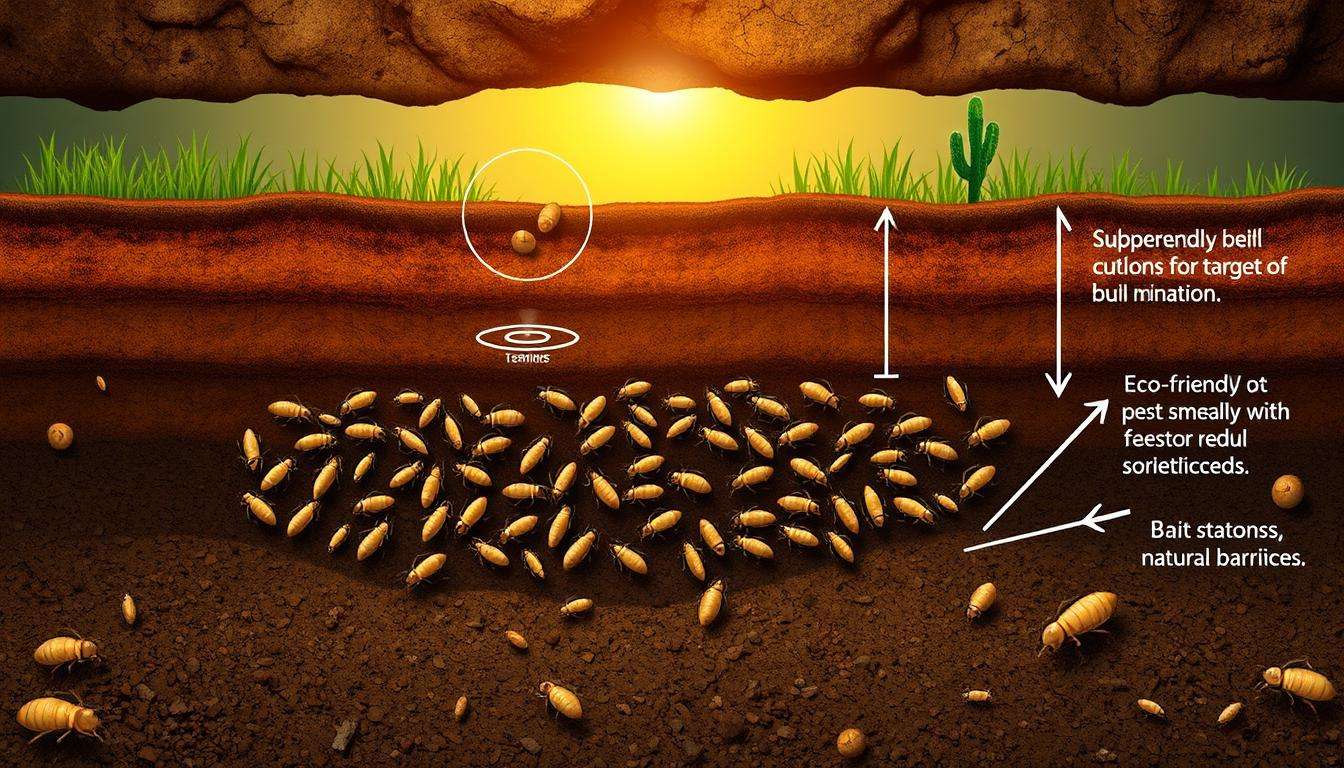Welcome to our guide on getting rid of subterranean termites! If you own a home or like to DIY, knowing how to control termites is important. These termites cause about 80% of termite damage worldwide, which is around $40 billion each year. With 45 termite species in the U.S., staying alert is crucial.
In this guide, we’ll share effective ways to get rid of subterranean termites. It’s important to know how these pests act to protect your home. Your home is likely your most valuable thing. Let’s learn how to fight these pests!
Key Takeaways
- Subterranean termites cause most termite damage worldwide.
- Knowing the signs of infestation is key for early action.
- Learning DIY methods can help you control termites better.
- For big infestations, you might need a pro.
- Using non-repellent termiticides can help more in the long run.
- Physical barriers are a must to prevent termites.
Understanding Subterranean Termites
It’s key for homeowners to know about subterranean termites. These pests live underground and can damage buildings if not stopped.
What Are Subterranean Termites?
Subterranean termites are bad for wooden buildings. They eat wood and plant stuff, causing big repair bills. Their colonies have millions of termites. They build mud tubes to move around.
Types of Subterranean Termites
There are many kinds of subterranean termites around the world. Each has its own ways of acting and causing damage. Some well-known ones are:
- Eastern Subterranean Termite (*Reticulitermes flavipes*)
- Western Subterranean Termite (*Reticulitermes hesperus*)
- Formosan Subterranean Termite (*Coptotermes formosanus*)
Knowing the different types helps find the best ways to stop them.
Social Structure and Behavior
Termites live in a special social order. They have different jobs:
- Workers: They find food, take care of the nest, and feed others.
- Soldiers: They protect the colony from enemies.
- Reproductives: They help the colony grow and start new nests.
This setup helps the colony work well and survive. Knowing this is important for treating them.

Signs of Subterranean Termite Infestation
Knowing the signs of subterranean termite infestation is crucial for homeowners. Spotting them early can prevent big damage and expensive fixes. By recognizing these signs, you can act fast to stop termites.
Common Indicators of Infestation
Some signs can help you catch a termite problem early. Here are key indicators to watch for:
- Swarming insects in spring and summer mean termites might be nesting nearby.
- Mud tubes on walls show termites are active and need moisture.
- Discarded wings are a sign termites have found a home.
- Termite droppings look like small sawdust piles and show damage.
- Bubbling or peeling paint can mean termites are under the surface.

Identifying Damage Caused by Subterranean Termites
Spotting termite damage is key since subterranean termites can cause a lot of harm before you see them. They eat wood from the inside, making damage hard to spot until it’s severe. Look for:
- Hollow-sounding wood: A simple tap test can reveal if wood has been hollowed out.
- Cracking wood and visible cracks in walls or ceilings may indicate structural damage.
- Sagging floors or buckling wood can signify significant damage requiring immediate attention.
- Small pinpoint holes in drywall often point to activity from these pests.
Regular checks and upkeep are vital to keep your home termite-free. If you see any signs of termites, act quickly to stop more damage and find the right solutions.
How to Get Rid of Subterranean Termites
Subterranean termites can damage your home badly if not treated. Knowing how to get rid of them can protect your property and save money. We’ll talk about DIY methods, when to call pest control, and soil treatments and baits.
DIY Termite Treatment Methods
Homeowners can try DIY termite treatments. Non-repellent termiticides are cheap and can save you money. They cost less than hiring professionals, who charge $500 to $1500.
Here’s how to do it yourself:
- Find where termites are.
- Drill holes 18 inches above the floor.
- Use non-repellent foams or sprays in these holes.
These products take up to 90 days to work. So, be patient.
When to Call a Pest Control Professional
DIY methods work well, but sometimes you need a pro. For big infestations or if DIY is too hard, get expert help. Professionals do detailed checks and use special treatments.
They find long-term solutions and use many methods to get rid of termites for good.
Soil Treatment and Baiting Systems
Soil treatments stop termites from getting to your home. You apply termiticides to the soil. Baiting systems are also good, as they attract and kill termites without harming the environment.
Here are your options:
- Soil Treatment: Use a liquid barrier.
- Baiting Systems: Use stations to kill termites.
Effective Termite Control Methods
Understanding how to control subterranean termites is key. These methods help lower the risk of infestations and keep your home safe. Non-repellent termiticides and physical barriers are top choices for keeping termites away.
Non-Repellent Termiticides
Non-repellent termiticides are a smart choice for fighting termites. They don’t scare termites away like regular repellents do. Instead, termites carry the termiticide back to their homes, killing the colony.
These treatments can last five to over ten years. This means your home stays protected for a long time.
- They come in liquids, sprays, and foams ready to use.
- Apply them around the house’s exterior, especially where termites are found.
- For a big house, you’ll need to dig a trench and use lots of termiticide.
It might take up to 90 days for these products to kill termites. But using them regularly can stop new problems.
Physical Barriers and Prevention Techniques
Preventing termites is part of keeping your home in good shape. Putting up physical barriers during building or fixing up can really help. Here are some tips:
- Use concrete or other materials instead of wood near the ground.
- Keep your home dry since termites love damp places.
- Check your home for termites at least once a year.
Conclusion
Managing subterranean termites well means knowing their habits and acting fast. These pests can cause huge damage, costing billions each year in the U.S. Use the termite extermination methods talked about to keep your home safe.
Watch for signs like mud tubes or swarmers if you think termites are around. Quick action stops them from causing a lot of harm. If you need help, call pest control experts. Also, take steps to keep your home safe from these pests.
Using good termite control methods is key for both quick fixes and long-term safety. Simple steps like letting sunlight in or using salt can help in mild cases. Stay informed and active to protect your home from subterranean termites.
